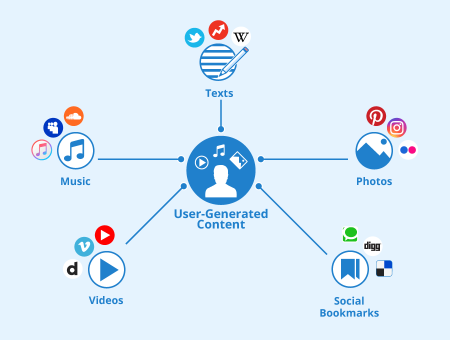User-Generated Content
Contents
Definition
User-generated content (UGC) refers to all media content published on the internet that users create themselves. It is a creative contribution by users, which is not embedded in professional routines.
Users and customers creating content on their own is not a new phenomenon. Newspapers have been relying on it for decades for the publication of readers’ letters or photos. In the age of social media, blogs, and similar internet platforms, UGC is experiencing a real boom. Many people no longer use the internet only for consumption, but also to produce own content.
Types of user-generated content

User-generated content comes in a wide variety of forms. The five most common types are texts, music, photos, videos, and social bookmarks.
User-generated texts include blog posts, comments, encyclopedia entries, product reviews, restaurant reviews, articles in web forums, etc. One of the best-known examples is Wikipedia: The world's most important online encyclopedia is based solely on the contributions of thousands of volunteer authors. And for shop providers like Amazon, customer reviews have been an important part of their corporate strategy for years.
User-generated music and audio content can be found on music and podcast platforms such as SoundCloud, MySpace, and iTunes. When it comes to photography, platforms such as Pinterest, Instagram, and Flickr play a key role. Not only professional photographers can build up a large fan base there.
User videos, as another form of UGC, are a success formula for YouTube, Vimeo, and other video portals. If you browse through current YouTube trends, you will almost exclusively come across content created by users. From product reviews to comedy clips, tutorials, and more: every day, individuals produce thousands of videos in every category - and millions of people watch them.
Last but not least, social bookmarking services such as Technorati, digg.com, and Delicious specialize in enabling users to create bookmark collections together. They allow you to create personal bookmarks and share them with others. In this way, people draw each other's attention to interesting links and provide them with short descriptions.
When looking at the different forms of user-generated content, it becomes clear that without all this content, the internet as we know it would not exist at all. The core of web 2.0 is that anyone can produce content. This idea has made the internet big - and will continue to expand it.
How can you benefit from UGC?
User-generated content is frequently used in marketing because it has a number of fundamental advantages. Above all, this type of content is particularly authentic and credible, which offers a simple and sustainable way to increase customer loyalty. Many companies use this type of content to improve their image, as customers often associate products and company names advertised by UGC with positive attributes. User-generated content is often distributed intensively over social networks. It usually contains links to your website, which increases its visibility. Extensive sharing of content also leads to networking effects: When a critical mass of users is reached, it automatically attracts new users through links and word of mouth.
In addition, UGC is rather cheap. Although its production became more and more professional in recent years, relatively few people are involved in it, so that costs can be kept low. This means that you can increase customer identification with your company or product in a relatively simple way. Contributions and reviews by private individuals can also increase sales, as they are considered independent and enjoy a high level of trust among other customers.
User-generated content also plays an important role in crowdsourcing: internal tasks can be handed over to volunteers via the internet. The majority of users are able to create diverse and high-quality content. Examples of this are competitions in which customers can submit suggestions for product designs, graphics, or slogans.
Advantages for companies summarized:
- Authenticity and credibility
- Increase of customer loyalty
- Image cultivation
- Increased range
- Low-cost content
- Increase in sales
- Crowdsourcing
User-generated content example
A nice example of how user-generated content can be employed is shown on the website of Zürich Tourism. Users are invited to post the most beautiful pictures of their visit to Zürich on Instagram. These images are then embedded on the tourist information website and aim to show the beautiful sides of Zürich.

Screenshot showing user-generated content of zuerich.com
Legal aspects
The use of this kind of content in marketing bears the risk of users violating certain laws. Examples are copyright infringements, violations of personal rights, trademark rights, and data protection guidelines. Since users are often anonymous, infringements mostly affect the providers of the platform.
In order to prevent legal violations, you can set up a reporting feature. This allows users to report violations, which you can review to track down and delete illegal content. You should also inform users about legal principles they should respect. Another solution are automatic filter mechanisms that independently search for problematic content.
Conclusion
UGC is a cost-effective and powerful marketing tool to improve your company's image, increase the reach of your website, and strengthen customer loyalty. The risks are manageable if users are well informed and illegal contributions are quickly deleted after they get noticed.
Related links
| About the author |
 |